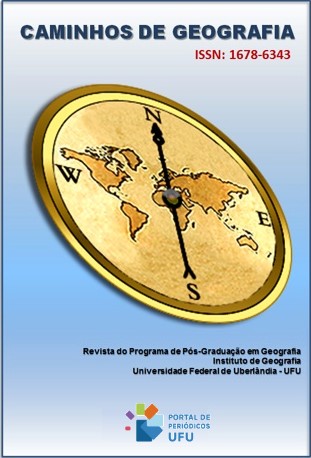MODELAGEM PREDITIVA DE DESMATAMENTO NA BACIA DO ALTO PARAGUAI NO ESTADO DE MATO GROSSO, BRASIL
DOI:
https://doi.org/10.14393/RCG2510171664Palabras clave:
Amazônia, Pantanal, Cerrado, Commodities, Modelos preditivosResumen
O objetivo deste estudo foi realizar simulação preditiva de desmatamento na bacia do Alto Paraguai no estado brasileiro de Mato Grosso, com o propósito de gerar informações para subsidiar estratégias de planejamento territorial voltadas à conservação ambiental. A modelagem foi operacionalizada no programa Dinamica EGO, a partir de dados de cobertura vegetal e de usos da terra, referentes ao período de 1985 a 2020, associado a variáveis explicativas do desmatamento na área investigada. Cinco etapas foram realizadas na metodologia: cálculo das matrizes de transição, determinação dos pesos de evidência, ajuste, validação e projeção do modelo no cenário tendencial para o ano de 2050. O modelo de simulação construído apresentou grau de acurácia de 75,60%. Três variáveis motrizes foram consistentemente associadas ao estímulo de desmatamento (proximidade às áreas previamente desmatadas, às estradas e às cidades). Em contrapartida, a proximidade às áreas protegidas apresentou um desestímulo ao desflorestamento. Para o ano de 2050 foi projetado para a bacia a perda de 21,20% (21.129,05 km²) de áreas de vegetação natural e aumento de 29,81% (21.135,47 km²) das áreas antrópicas agrícolas. Nesse cenário as áreas antrópicas agrícolas terão 92.029,92 km², superado as áreas de vegetação natural com 78.507,56 km² em 2040.
Descargas
Descargas
Publicado
Número
Sección
Licencia
Derechos de autor 2024 Alexander Webber Perlandim Ramos, Úrsula Ruchkys de Azevedo, Edineia Aparecida dos Santos Galvanin

Esta obra está bajo una licencia internacional Creative Commons Atribución-NoComercial-SinDerivadas 4.0.
Los autores que publican en esta Revista aceptan los siguientes términos: a) Autores conserva los derechos de autor y otorga a la revista el derecho de primera publicación, con el trabajo bajo licencia Creative Commons Attribution-NonCommercial NoDerivs 4.0 International. b) Se permite y anima a los autores a publicar y distribuya su trabajo en línea (por ejemplo, en repositorios institucionales o en su sitio web personal), ya que esto puede generar cambios productivos, así como incrementar el impacto y cita de trabajo publicado. c) Por el hecho de aparecer en este diario de acceso público, los artículos son de libre uso, con sus propias atribuciones, en aplicaciones educativos y no comerciales.











